Data Center Blade Server Market Size
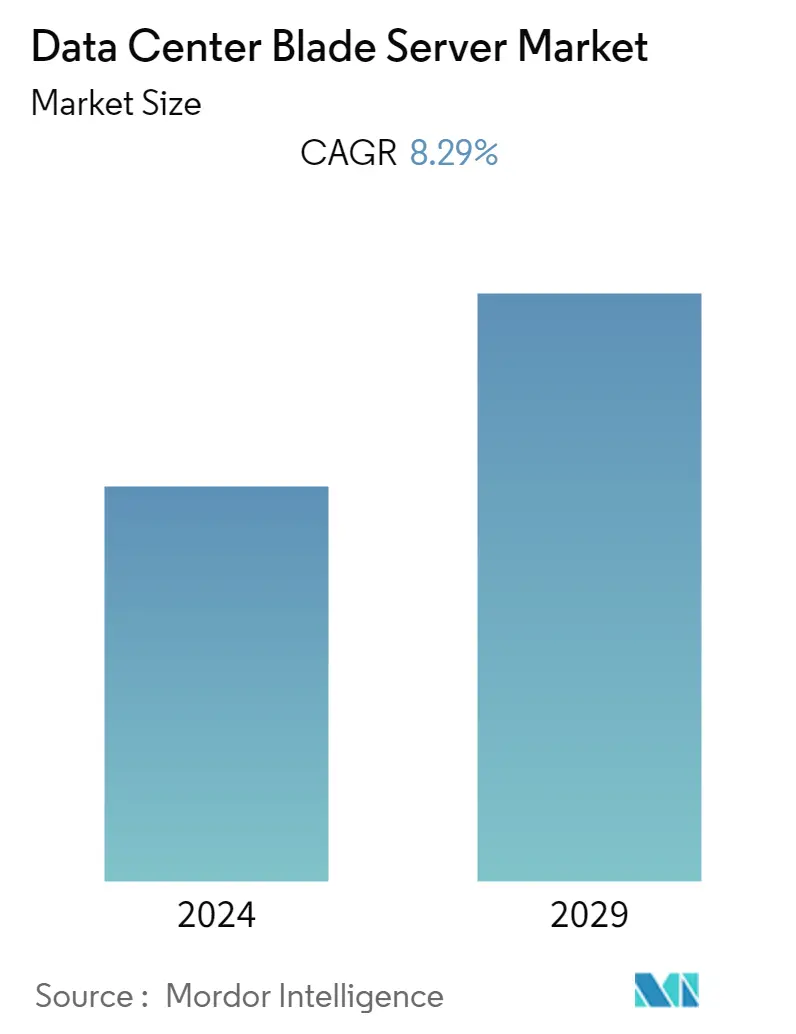
| Study Period | 2021 - 2029 |
| Base Year For Estimation | 2023 |
| CAGR | 8.29 % |
| Fastest Growing Market | Asia-Pacific |
| Largest Market | North America |
| Market Concentration | High |
Major Players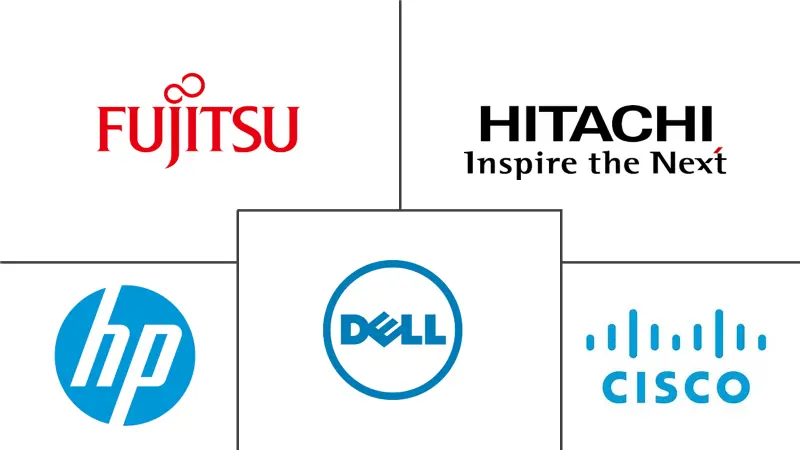
*Disclaimer: Major Players sorted in no particular order |
Data Center Blade Server Market Analysis
The data center blade server market is expected to register a CAGR of over 8.29% over the forecast period. A blade server is a modular server compared to a rack server, which enables multiple servers to be housed in a more compact area than a rack server. These servers are designed to be thin and have only CPUs, memory, integrated network controllers, and sometimes built-in storage drives. Additionally, it consumes less power, resulting in lower operational costs. These are some of the factors driving the market for data center blade servers.
- Single or multiple server blades can be inserted or removed without distressing another running system. It reduces hardware costs, which is likely to entice industry players to adopt the technology, thereby fueling market growth.Additionally, each server blade does not consist of a distinct infrastructure and chassis, owing to which the product is relatively cheaper as compared to other solutions.
- Cloud computing is one of the industries that has had a significant impact on the data center colocation industry.The adoption of cloud computing has been proliferating over the past few years.
- Regarding the data center infrastructure, global corporations offering cloud services and third-party vendors have been identified to support their services with hyper-scale data centers and blade servers to reduce operational costs. Combining blade servers with the cloud can help reduce operational costs and increase efficiency. Cloud provider companies require private networks with high levels of bandwidth and resiliency, as well as support from a robust data center provider.
- However, when compared to rack servers, the adoption of blade servers has a higher initial cost, which limits market growth to some extent.
- With the onset of the COVID-19 pandemic, different supply chains across many industries were affected, including data center infrastructure. All major components of a data center were built off-site, delivered, and then installed, which indicates vulnerable breakage points for the market's supply chain. However, the increased cloud migrations of various industries boosted the demand for data centers in the post-Covid scenario.
Data Center Blade Server Market Trends
This section covers the major market trends shaping the Data Center Blade Server Market according to our research experts:
Healthcare Segment is Expected to Witness a Significant Growth
- Digitization of consumer health records in the form of electronic medical records (EMR) contributes to data accumulation. The latest innovations in medical equipment and modernization of legacy operating systems, such as personnel management, patient response systems improvement, etc., generate a multitude of data, further necessitating the need for data centers. This need for data centers, in turn, drives the demand for data center cooling.
- In the coming future, the evolution of healthcare will focus on the reengineering of clinical care and operations around digital health and the pervasive, real-time use of data and advanced analytics to achieve these goals. Such achievements would require a large amount of data to be stored, which would drive the need for data center blade servers over the forecast period.
- Telemedicine is increasing in usage owing to various advantages, such as consumers from any region being able to gain access to the required doctor. It is an efficient method, as both money and time are saved, owing to the change in the typically scheduled visits, thereby generating a lot of data and emphasizing the need for data centers.
Moreover, the government across various regions is taking initiatives to support the growth of data centers in healthcare. For instance, in November 2022, the Indian government announced the launch of a national repository for life science data. The Indian Biological Data Center (IBDC) is situated at the Regional Centre for Biotechnology in Faridabad. The IBDC has a four-petabyte data storage capacity and houses the Brahm high-performance computing facility. It also runs an online dashboard that provides customized access, data submission, data analysis services, and real-time SARS-CoV-2 variant monitoring.
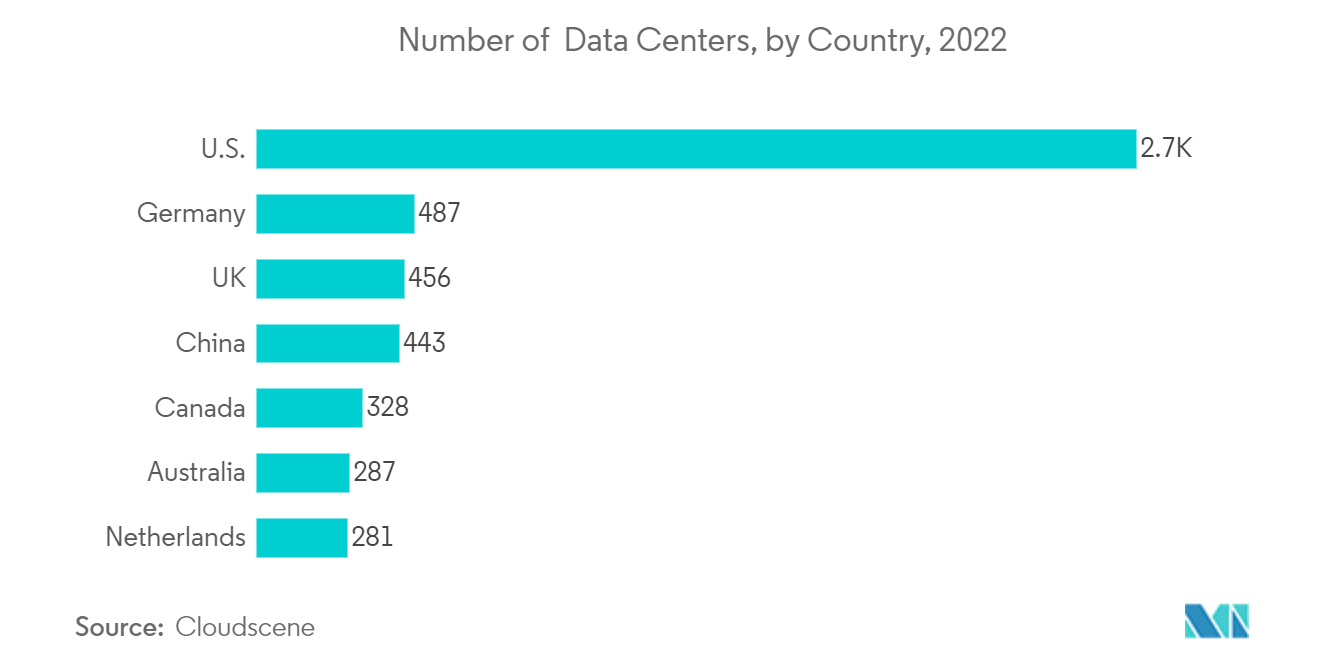
North America to Hold a Largest Share
- The region is seeing a shift away from individual device and system storage and toward the core cloud and network edge.According to a survey by Intel Security, the number of companies adopting hybrid cloud services alone has risen by three times the previous level. Cloud providers have been increasing security and enabling better and more robust systems in organizations, which can be highly beneficial.
- Also, companies in the area are putting a lot of money into AI infrastructure, which means that the huge amounts of data being collected in real time need to be processed right away.
- According to CBRE, Northern Virginia remained the world's largest data center market and added 185.1 MW of new supply in the second half of 2021. It is building 239 MW of wholesale colocation space, of which 100 MW has already been leased.
- Moreover, in January 2023, Amazon announced its plan to invest USD 35 billion over the next two decades to expand its data center business across Virginia. If approved by Virginia lawmakers, the company would receive up to USD 140 million in economic incentives from the state and as many as 15 years of additional tax breaks for equipment and software.
- In January 2023, ManageEngine, the enterprise IT management division of Zoho Corporation, announced the launch of two new Canadian data centers in Toronto and Montreal, offering enhanced data security and privacy to regional customers. Owing to the increased privacy regulations and performance requirements, large enterprises in Canada, including those in the government, banking, and financial services sectors, are placing an increased emphasis on localized data storage and processing.
During the forecast period, companies and governments in the region are expected to keep working on these kinds of projects and make large investments. This is expected to increase the demand for data center blade servers in the region.
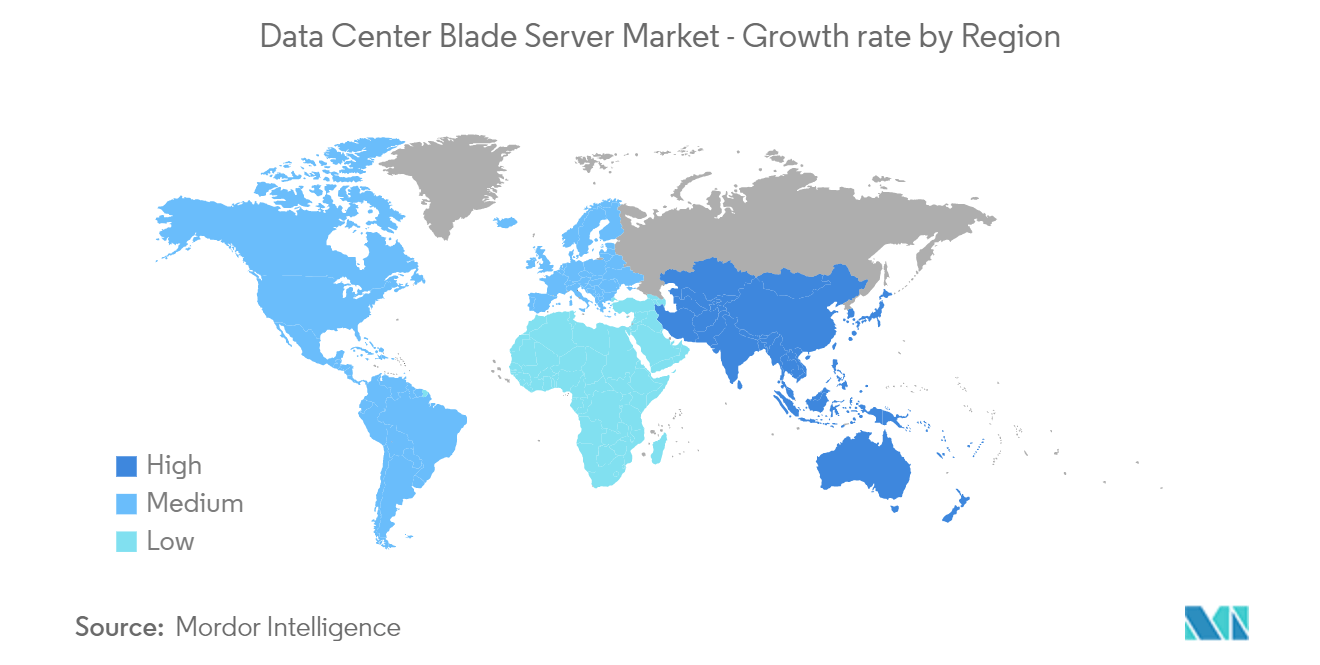
Data Center Blade Server Industry Overview
The market for data center blade servers is moderately consolidated, with the presence of some significant players in the market. Additionally, these companies are continuously investing in strategic acquisitions and partnerships to gain more market share. Moreover, as the companies need higher initial capital costs to enter the market, the barrier to entry for new players is high. Some of the recent developments by these companies are mentioned below.
- January 2023 - Cisco, in partnership with Intel, announced the launch of new servers powered by the advanced Intel Xeon processors. Intel unveiled the 4th Gen Intel Xeon Scalable processors, while Cisco introduced the new flexible, more powerful, and sustainable servers based on Intel innovation. Powered and managed by Intersight, the UCS X-Series can support workloads on a blade-server architecture that has historically been only practical on rack-based servers.
- January 2023 - Cisco announced the launch of the 7th generation of UCS C-Series and X-Series servers, powered by 4th generation Intel Xeon Scalable processors. With support for the latest Intel processors, Cisco has launched two new blades for the X-Series: the Cisco UCS X210c M7 Compute Node and the Cisco UCS X410c M7 Compute Node.
Data Center Blade Server Market Leaders
-
Cisco Systems Inc.
-
Hewlett Packard Enterprise Co
-
Fujitsu Limited
-
Dell, Inc.
-
Hitachi, Limited
*Disclaimer: Major Players sorted in no particular order
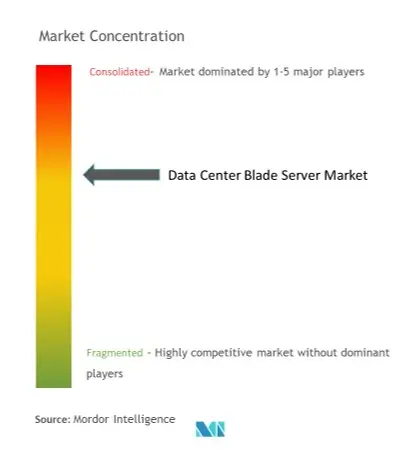
Data Center Blade Server Market News
- January 2023 - Supermicro announced the launch of its new server and storage portfolio with more than 15 families of performance-optimized systems focusing on cloud computing, AI, and HPC, as well as enterprise, media, and 5G/telco/edge workloads. SuperBlade would deliver the computational performance of a whole server rack in a considerably smaller physical footprint by using shared, redundant components, including cooling, networking, power, and chassis management. These blade server systems are geared for AI, Data Analytics, HPC, Cloud, and Enterprise applications and feature GPU-enabled blades.
- May 2022 - Nvidia announced the launch of four arm-based grace server designs for a diverse range of HPC, AI, and cloud applications. The new HGX Grace and HGX Grace Hopper platforms are designed for 2U server chassis from Nvidia OEM partners. The HGX Grace Hopper 2U chassis implements two Grace Hopper blades, with each providing 512 gigabytes of LPDDR5X as well as 80 gigabytes of HBM3 memory and memory bandwidth up to 3.5 terabytes per second.
Data Center Blade Server Market Report - Table of Contents
1. INTRODUCTION
- 1.1 Study Assumptions and Market Definition
- 1.2 Scope of the Study
2. RESEARCH METHODOLOGY
3. EXECUTIVE SUMMARY
4. MARKET INSIGHTS
- 4.1 Market Overview
- 4.2 Industry Value Chain Analysis
-
4.3 Industry Attractiveness - Porter's Five Forces Analysis
- 4.3.1 Threat of New Entrants
- 4.3.2 Bargaining Power of Buyers/Consumers
- 4.3.3 Bargaining Power of Suppliers
- 4.3.4 Threat of Substitute Products
- 4.3.5 Intensity of Competitive Rivalry
- 4.4 COVID-19 Impact on the Market
5. MARKET DYNAMICS
- 5.1 Market Overview
- 5.2 Introduction to Market Drivers and Restraints
-
5.3 Market Drivers
- 5.3.1 High Density Servers Per Rack
- 5.3.2 Low Operational Cost and Power Consumption
- 5.3.3 Increasing Adoption of Cloud and IoT Services
-
5.4 Market Restraints
- 5.4.1 High Initial Investments
6. MARKET SEGMENTATION
-
6.1 Type
- 6.1.1 Tier 1
- 6.1.2 Tier 2
- 6.1.3 Tier 3
- 6.1.4 Tier 4
-
6.2 End-user Verticals
- 6.2.1 BFSI
- 6.2.2 Manufacturing
- 6.2.3 Energy & Utility
- 6.2.4 Healthcare
- 6.2.5 Other End-user Verticals
-
6.3 Geography
- 6.3.1 North America
- 6.3.1.1 United States
- 6.3.1.2 Canada
- 6.3.2 Europe
- 6.3.2.1 Germany
- 6.3.2.2 United Kingdom
- 6.3.2.3 Rest of Europe
- 6.3.3 Asia-Pacific
- 6.3.3.1 China
- 6.3.3.2 Japan
- 6.3.3.3 India
- 6.3.3.4 Rest of Asia-Pacific
- 6.3.4 Latin America
- 6.3.4.1 Brazil
- 6.3.4.2 Mexico
- 6.3.4.3 Rest of Latin America
- 6.3.5 Middle-East & Africa
- 6.3.5.1 United Arab Emirates
- 6.3.5.2 Saudi Arabia
- 6.3.5.3 Rest of Middle-East & Africa
7. COMPETITIVE LANDSCAPE
-
7.1 Company Profiles
- 7.1.1 Cisco Systems, Inc.
- 7.1.2 Dell, Inc.
- 7.1.3 Fujitsu Limited
- 7.1.4 Hewlett-Packard Company
- 7.1.5 Hitachi, Limited
- 7.1.6 Huawei Technologies Co., Ltd.
- 7.1.7 Lenovo Group Limited
- 7.1.8 NEC Corporation
- 7.1.9 Oracle Corporation
- *List Not Exhaustive
8. INVESTMENT ANALYSIS
9. FUTURE OF THE MARKET
** Subject To AvailablityData Center Blade Server Industry Segmentation
A blade server is a small, standalone server comprised of central processing units that can fit within an enclosure with other blade servers. Blade servers are designed to overcome the space and energy restrictions of a typical data center environment. The study of the data center blade server market is limited to the types of data center blade servers offered by the vendors for application in a wide range of industries across the world.
The Data Center Blade Server Market is segmented by Data Center Type (Tier 1, Tier 2, Tier 3, Tier 4), End-user Vertical (BFSI, Manufacturing, Energy and Utility, Healthcare), and Geography (North America(United States, Canada), Europe(Germany, United Kingdom), Asia-Pacific(China, Japan, India), Latin America(Brazil, Mexico), and Middle East and Africa(United Arab Emirates, Saudi Arabia)).
The market sizes and forecasts are provided in terms of value (USD million) for all the above segments.
| Type | Tier 1 | |
| Tier 2 | ||
| Tier 3 | ||
| Tier 4 | ||
| End-user Verticals | BFSI | |
| Manufacturing | ||
| Energy & Utility | ||
| Healthcare | ||
| Other End-user Verticals | ||
| Geography | North America | United States |
| Canada | ||
| Geography | Europe | Germany |
| United Kingdom | ||
| Rest of Europe | ||
| Geography | Asia-Pacific | China |
| Japan | ||
| India | ||
| Rest of Asia-Pacific | ||
| Geography | Latin America | Brazil |
| Mexico | ||
| Rest of Latin America | ||
| Geography | Middle-East & Africa | United Arab Emirates |
| Saudi Arabia | ||
| Rest of Middle-East & Africa |
Data Center Blade Server Market Research FAQs
What is the current Data Center Blade Server Market size?
The Data Center Blade Server Market is projected to register a CAGR of 8.29% during the forecast period (2024-2029)
Who are the key players in Data Center Blade Server Market?
Cisco Systems Inc., Hewlett Packard Enterprise Co, Fujitsu Limited, Dell, Inc. and Hitachi, Limited are the major companies operating in the Data Center Blade Server Market.
Which is the fastest growing region in Data Center Blade Server Market?
Asia-Pacific is estimated to grow at the highest CAGR over the forecast period (2024-2029).
Which region has the biggest share in Data Center Blade Server Market?
In 2024, the North America accounts for the largest market share in Data Center Blade Server Market.
What years does this Data Center Blade Server Market cover?
The report covers the Data Center Blade Server Market historical market size for years: 2021, 2022 and 2023. The report also forecasts the Data Center Blade Server Market size for years: 2024, 2025, 2026, 2027, 2028 and 2029.
Data Center Blade Server Industry Report
Statistics for the 2024 Data Center Blade Server market share, size and revenue growth rate, created by Mordor Intelligence™ Industry Reports. Data Center Blade Server analysis includes a market forecast outlook to 2029 and historical overview. Get a sample of this industry analysis as a free report PDF download.



